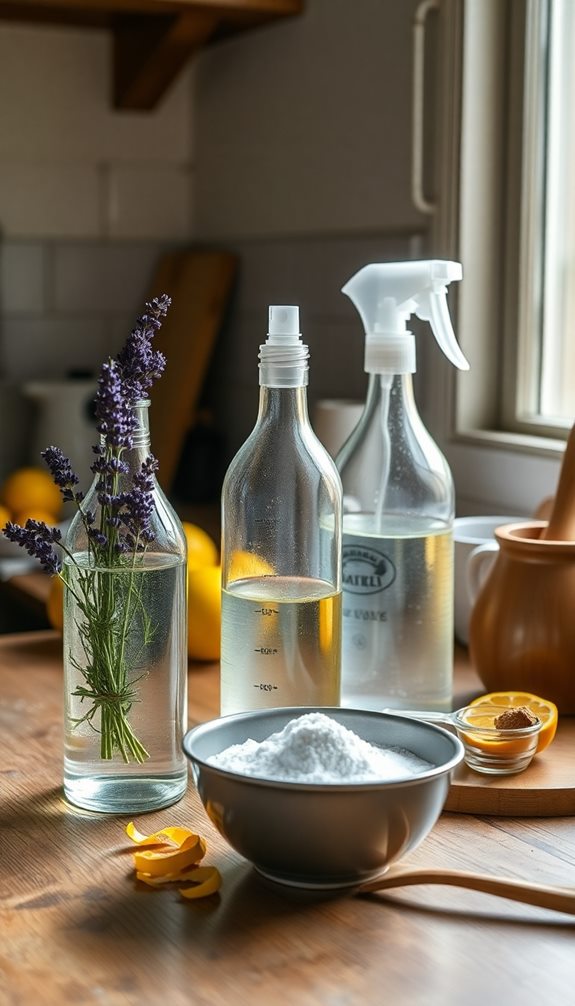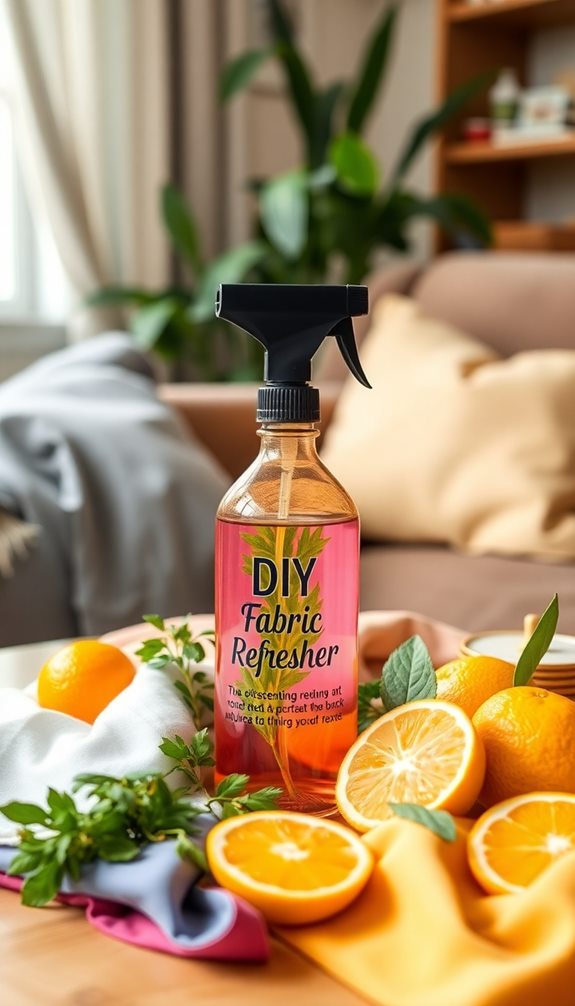Making your own natural fabric refresher is easy and cost-effective. Start with a clean 16-ounce glass spray bottle. Combine 1/4 cup of high-proof vodka or rubbing alcohol with 1/2 cup of distilled water. Add 10-15 drops of your favorite essential oil for a pleasant scent. Shake it well before each use to guarantee even distribution. Remember to spot test your fabric to avoid stains. This DIY spray keeps your environment fresh while reducing exposure to harsh chemicals. Want more tips on customization and usage? There's plenty more you can explore for perfecting your fabric refreshers!
Benefits of DIY Fabric Refresher
DIY fabric refresher offers a smart way to keep your home smelling fresh without breaking the bank. This cost-effective alternative to commercial options allows you to save money while enjoying a cleaner environment.
By using natural ingredients, you minimize your exposure to harmful chemicals and synthetic fragrances, promoting a healthier living space for you and your family. Additionally, opting for a natural fabric spray helps enhance indoor air quality, contributing to your overall well-being and reducing allergens, making it a safer indoor environment.
One of the standout benefits of a DIY fabric refresher is its customizable scents. You can tailor the aroma and potency to fit your personal preferences, ensuring your home smells just the way you like it.
Plus, incorporating essential oils not only adds fragrance but can also provide antimicrobial properties. This helps eliminate odors and reduce allergens and bacteria in your fabrics, leading to a fresher atmosphere.
Creating your own fabric refresher also aligns with environmental sustainability. By making your spray, you can greatly reduce plastic waste associated with single-use commercial products.
Opting for refillable solutions helps you contribute positively to the environment while enjoying a fresh-smelling home. Embrace the benefits of a DIY fabric refresher and enjoy a healthier, more sustainable living space.
Ingredients for Your Fabric Spray
Creating your own fabric spray requires just a few simple ingredients that you likely already have at home. To get started, you'll need 1/4 cup of high-proof vodka or rubbing alcohol. This ingredient is essential for effectively neutralizing odors in your fabric.
For an eco-friendly cleaning approach, you can also incorporate natural disinfectants, like distilled white vinegar, in your spray. Next, incorporate 1/2 cup of distilled water or cooled boiled water. This dilution helps prevent any mineral deposits from forming in your homemade natural fabric revitalizer.
For a lovely scent, add 10-30 drops of your favorite essential oil, like lavender or lemon. These oils provide an invigorating fragrance without the harmful chemicals found in many commercial sprays.
When combining your ingredients, a glass spray bottle is highly recommended. Not only is it reusable, but it also helps reduce plastic waste.
Lastly, if you plan to create multiple scents or formulas, consider labeling your glass spray bottles. This simple step makes it easy to identify each DIY fabric freshener, ensuring you always grab the right one for your needs.
With these ingredients on hand, you're well on your way to creating a delightful fabric spray that keeps your home smelling fresh!
Steps to Make the Spray

To make your fabric spray, start by combining 1 part high-proof vodka or rubbing alcohol with 1 part distilled water in a 16-ounce glass spray bottle. This mixture effectively neutralizes odors while diluting the alcohol.
For added benefits, consider using a homemade furniture deodorizer that combines baking soda with essential oils, as it effectively eliminates odors and promotes a refreshed living space using DIY deodorizers.
Next, add 10-15 drops of your chosen essential oils, like lavender or lemon, to give your homemade fabric spray a pleasant scent without harmful chemicals. If you'd like to boost the deodorizing properties, mix in 1-2 teaspoons of baking soda, guaranteeing it's well dissolved to avoid clogging the nozzle.
Once you've added all the ingredients, it's time to close the bottle and shake the bottle gently before each use. This guarantees proper mixing of ingredients and even distribution of fragrance.
Before you start cleaning your fabrics, always perform a spot test on a small, inconspicuous area. This step helps you check for any potential staining or adverse reactions, guaranteeing your DIY refresher is safe for use.
Now you're ready to spray right and enjoy fresh-smelling fabrics throughout your home!
Tips for Effective Use
After you've made your fabric refresher, using it effectively can make all the difference in achieving fresh-smelling fabrics. Here are some tips to help you get the most out of your DIY fabric spray:
- Shake the Spray Bottle: Always shake your homemade fabric refresher spray before each use. This guarantees the ingredients are well mixed, and the scent is evenly distributed. Incorporating non-toxic ingredients can enhance the freshness while keeping your household safe.
- Test the Spray: Before applying the natural fabric freshener to larger areas, test the spray on a small, inconspicuous fabric surface. This checks for any staining or adverse reactions.
- Allow to Air Dry: After you give a quick spritz of the refresher, let the sprayed fabric air dry completely. This allows the essential oil blends to release their fragrance effectively.
- Use Baking Soda Sparingly: If you're adding baking soda for odor neutralization, limit it to 1-2 teaspoons. Be cautious, though; it can leave white spots on colored fabrics.
Community Feedback and Ideas

While many have turned to DIY fabric refresher sprays, community feedback reveals a strong preference for their effectiveness and natural ingredients. Users consistently report that these homemade fabric fresheners outperform commercial options, delivering fresh scents and improved odor elimination without the toxic chemicals often found in store-bought products.
Additionally, by incorporating key natural ingredients like lemon juice and baking soda, these fabric sprays can offer enhanced cleaning power. You can make homemade fabric freshener that caters to your unique preferences by experimenting with essential oils. Many community members share their favorite combinations, such as lemon and chamomile, to create personalized fragrances that resonate with their style.
Additionally, concerns about the strong odor of rubbing alcohol have led to suggestions for milder alternatives like vodka or witch hazel, making your homemade fabric freshener spray even more pleasant to use.
The versatility of these DIY cleaning recipes is another highlight, with users finding them suitable for various applications, including upholstery, bedding, and even car interiors. When you make your own fabric refresher, remember to test your fabric first to ascertain compatibility.
Embracing this community-driven creativity not only enhances your home's scent but also supports a healthier environment.
Conclusion
Making your own fabric refresher is simple, cost-effective, and eco-friendly. By using natural ingredients, you not only freshen your fabrics but also reduce your exposure to harsh chemicals. So, embrace creativity, enjoy the process, and enhance your home's ambiance. With a little effort, you can transform your space, uplift your mood, and create a welcoming environment. Remember, a fresh home is a happy home, and each spray you make brings you closer to that blissful atmosphere.